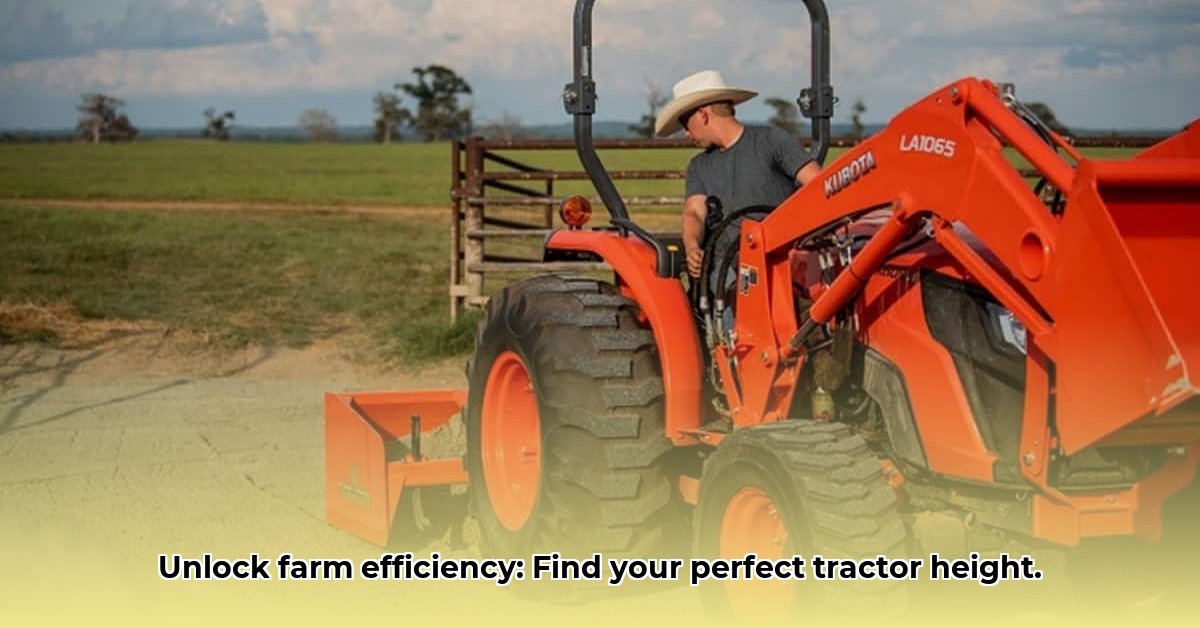
How Tractor Height Impacts Farm Operations
Choosing the right tractor involves more than just horsepower; the overall height is critical for efficient and safe operation. Ignoring tractor height can lead to costly mistakes and operational inefficiencies. A tractor that's too tall might not fit under low-hanging barn roofs or through narrow gateways, significantly limiting its usefulness. Conversely, a tractor that's too short might lack the ground clearance needed for certain tasks or uneven terrain. To help with budgeting, check out tractor pricing.
Understanding the Importance of Height
Tractor height directly impacts your farm's workflow. A tall tractor might struggle in confined spaces like orchards or vineyards, while a shorter one may be less stable on uneven terrain. Before you even begin shopping, carefully measure all areas where your tractor will operate. This includes gateways, barn doors, and overhead obstacles like power lines or tree branches. Failing to do this could result in a costly and frustrating situation.
Matching Tractor Height to Your Farm's Specific Needs
The ideal tractor height depends entirely on your farm's unique requirements. Smaller, lower tractors excel in precision work in confined areas, such as vineyards or orchards where maneuverability is paramount. For heavy-duty tasks across large fields, however, a larger, taller tractor is generally more efficient.
What are your primary farming tasks? How much space do you have to work with? Answering these questions will guide you toward the best tractor height for your operations.
Assessing Your Farm's Infrastructure: A Critical First Step
Before researching specific tractor models, thoroughly assess your farm's infrastructure. This crucial step will help determine the maximum permissible tractor height. Accurate measurements will prevent costly errors and ensure your new tractor seamlessly integrates into your existing operations.
Measuring Your Farm: A Step-by-Step Guide
Follow these steps to take accurate and reliable measurements:
- Identify all potential height restrictions: This includes barn doors, gateways, low-hanging branches, power lines, and any other obstacles that could impede a taller tractor.
- Use a measuring tape (and a helper!): Carefully measure the height of each potential obstacle. A second person can ensure accuracy and assist with reaching difficult spots.
- Add extra clearance: Always add at least 6-12 inches (15-30 cm) to your measurements to account for uneven ground and provide additional clearance for safe operation.
- Document your findings: Keep a detailed record of your measurements for reference when comparing tractor models.
Comparing Tractor Heights: Model-Specific Considerations
Tractor heights vary significantly across manufacturers and models. Compact tractors typically measure under 8 feet (2.4 meters), whereas larger models can exceed 10 feet (3 meters). Always consult the manufacturer's specifications for precise dimensions. These are usually found in brochures, owner's manuals, or online resources.
Dr. Emily Carter, Agricultural Engineering Professor at State University, emphasizes, "Always prioritize checking the manufacturer's specifications. Approximate heights can be misleading and lead to incorrect purchasing decisions."
Beyond Height: Weight and Width Considerations
While height is crucial, don't overlook weight and width. Heavier tractors offer more stability, especially on slopes, but can compact soil. Wider tractors are more stable but less maneuverable in tight spaces. The optimal balance depends on your farm's layout and tasks. For example, smaller, higher-clearance tractors are often preferred in certain situations.
Choosing Your Tractor: A Holistic Approach
Selecting the right tractor involves more than just height; consider horsepower, required attachments, and fuel efficiency. Careful consideration will save you time and money in the long run. Remember, the best tractor is one that perfectly matches your farm's layout and specific needs.
Key Takeaways:
- Tractor height significantly influences operational efficiency and safety.
- Careful pre-planning, including detailed measurements, is crucial.
- The optimal tractor height depends on your farm's layout and operational needs.
- Consider weight and width alongside height for a balanced assessment.
- Prioritize a tractor that matches your specific needs for long-term success.